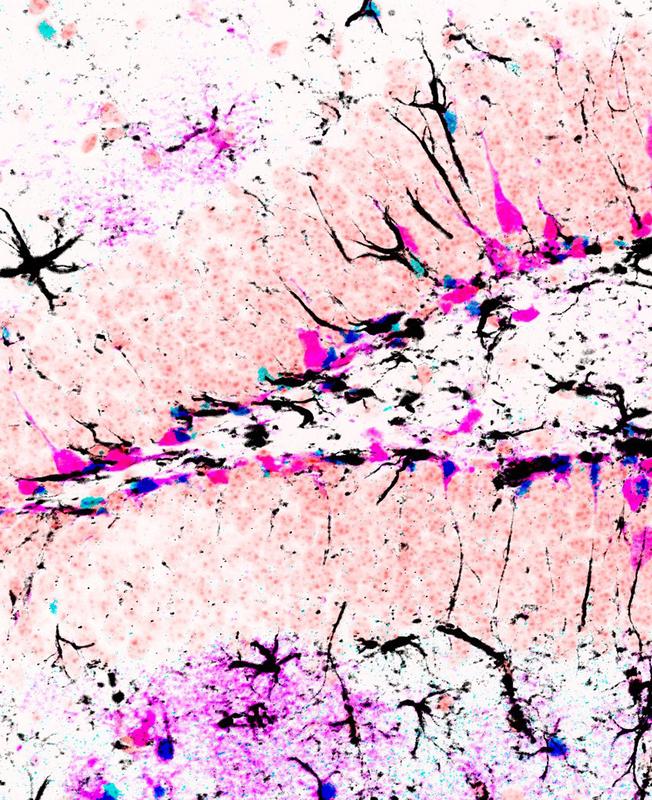Signal blocks stem cell division in the geriatric brain

The image depicts Id4 (blue) and GFAP (black) expression in genetically labeled stem cells and their progeny (magenta) in the hippocampus of the mouse brain. University of Basel
Whether stem cells also occur in the human brain has long been controversial. Today, it is considered certain that the brain can form new neurons throughout life. The stem cells that have been found to be behind this process are restricted to specialized regions in the brain, so-called niches, which provide key signals that regulate stem cell self-renewal and differentiation. With increasing age, however, the stem cells become increasingly inactive and divide less frequently. They transition into a “quiescent” or dormant state.
Hyperactive signaling pathway inhibits cell division
So far, it was unclear why stem cells in the adult and aged brain fall into a state of rest. A research team led by Prof. Verdon Taylor from the Department of Biomedicine at the University of Basel has now discovered which factors block entry of stem cells into cell division. They were investigating the so-called Notch signaling pathway in more detail, a pathway central for regulating stem cell activity in the brain.
The study shows that the Notch2 signaling pathway controls the expression of a specific transcription regulator called Id4. Once expressed, Id4 inhibits the division of stem cells and blocks the production of new neurons in the hippocampus of the adult brain. Notch2 signaling maintains high levels of Id4 in some neural stem cells, and thereby explains why these stem cells increasingly enter a state of rest in the adult and geriatric brain.
As the brain ages, the Notch2-Id4 pathway enters into a state of hyperactivity, presenting a strong molecular brake that inhibits stem cell activation and neuron production. Conversely, inactivation of this pathway releases the brake and enables the production of new neurons – even in the brain of geriatric mice.
Reversible resting state
The results show that the stem cells in the mammalian brain are in a reversible resting state regulated by signals and factors in the niche. By manipulating the signaling pathway, the production of new nerve cells can be specifically stimulated.
The study provides important information on the basic mechanisms of neurogenesis in the adult mouse brain. Since the Notch signaling pathway is widespread and occurs in most organisms, the researchers hope that the findings can also be transferred to humans. In this way, brain damage caused by degenerative and neuropsychiatric diseases could be repaired in the future.
Verdon Taylor, Universität Basel, Departement Biomedizin, Tel. +41 61 207 30 91, E-Mail: verdon.taylor@unibas.ch
Runrui Zhang, Marcelo Boareto, Anna Engler, Angeliki Louvi, Claudio Giachino, Dagmar Iber and Verdon Taylor
Id4 downstream of Notch2 maintains neural stem cell quiescence in the adult hippocampus
Cell Reports (2019), doi: 10.1016/j.celrep.2019.07.014
https://www.unibas.ch/en/News-Events/News/Uni-Research/Signal-blocks-stem-cell-d…
Media Contact
All latest news from the category: Life Sciences and Chemistry
Articles and reports from the Life Sciences and chemistry area deal with applied and basic research into modern biology, chemistry and human medicine.
Valuable information can be found on a range of life sciences fields including bacteriology, biochemistry, bionics, bioinformatics, biophysics, biotechnology, genetics, geobotany, human biology, marine biology, microbiology, molecular biology, cellular biology, zoology, bioinorganic chemistry, microchemistry and environmental chemistry.
Newest articles

A universal framework for spatial biology
SpatialData is a freely accessible tool to unify and integrate data from different omics technologies accounting for spatial information, which can provide holistic insights into health and disease. Biological processes…

How complex biological processes arise
A $20 million grant from the U.S. National Science Foundation (NSF) will support the establishment and operation of the National Synthesis Center for Emergence in the Molecular and Cellular Sciences (NCEMS) at…

Airborne single-photon lidar system achieves high-resolution 3D imaging
Compact, low-power system opens doors for photon-efficient drone and satellite-based environmental monitoring and mapping. Researchers have developed a compact and lightweight single-photon airborne lidar system that can acquire high-resolution 3D…





















